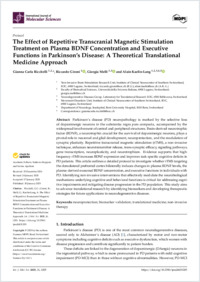The effect of repetitive transcranial magnetic stimulation treatment on plasma BDNF concentration and executive functions in Parkinson’s disease : a theoretical translational medicine approach
- Riccitelli, Gianna Carla ORCID Non-Invasive Brain Stimulation Research Unit, Institute of Clinical Neurocenter of Southern Switzerland, EOC, Lugano, Switzerland - Faculty of Biomedical Sciences, Università della Svizzera italiana, Switzerland
- Gironi, Riccardo Non-Invasive Brain Stimulation Research Unit, Institute of Clinical Neurocenter of Southern Switzerland, EOC, Lugano, Switzerland
- Melli, Giorgia ORCID Faculty of Biomedical Sciences, Università della Svizzera italiana, Switzerland - Neurodegenerative Diseases Group, Laboratory for Translational Research EOC, Bellinzona, Switzerland
- Kaelin-Lang, Alain ORCID Non-Invasive Brain Stimulation Research Unit, Institute of Clinical Neurocenter of Southern Switzerland, EOC, Lugano, Switzerland - Faculty of Biomedical Sciences, Università della Svizzera italiana, Switzerland - Neurodegenerative Diseases Group, Laboratory for Translational Research EOC, Bellinzona, Switzerland - Movement Disorders Unit, Institute of Clinical Neurocenter of Southern Switzerland, EOC, Lugano, Switzerland - Department of Neurology, Inselspital, Bern University Hospital, Switzerland
- 2025
Published in:
- International Journal of Molecular Sciences. - 2025, vol. 26, no. 3, p. 1205
English
Parkinson’s disease (PD) neuropathology is marked by the selective loss of dopaminergic neurons in the substantia nigra pars compacta, accompanied by the widespread involvement of central and peripheral structures. Brain-derived neurotrophic factor (BDNF), a neurotrophin crucial for the survival of dopaminergic neurons, plays a pivotal role in neuronal and glial development, neuroprotection, and the modulation of synaptic plasticity. Repetitive transcranial magnetic stimulation (rTMS), a non-invasive technique, enhances neurotransmitter release, trans-synaptic efficacy, signaling pathways, gene transcription, neuroplasticity, and neurotrophism. Evidence supports that high-frequency rTMS increases BDNF expression and improves task-specific cognitive deficits in PD patients. This article outlines a detailed protocol to investigate whether rTMS targeting the dorsolateral prefrontal cortex bilaterally induces changes in plasma BDNF levels, the plasma-derived exosomal BDNF concentration, and executive functions in individuals with PD. Identifying non-invasive interventions that effectively modulate the neurobiological mechanisms underlying cognitive and behavioral functions is critical for addressing cognitive impairments and mitigating disease progression in the PD population. This study aims to advance translational research by identifying biomarkers and developing therapeutic strategies for future applications in neurodegenerative diseases.
- Collections
- Language
-
- English
- Classification
- Medicine
- License
- Open access status
- gold
- Identifiers
-
- DOI 10.3390/ijms26031205
- ARK ark:/12658/srd1332025
- Persistent URL
- https://n2t.net/ark:/12658/srd1332025
Statistics
Document views: 46
File downloads:
- Riccitelli_MDPI_2025_ijms_The effect of repetitive: 44
